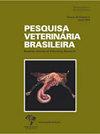对足部相关疾病采取预防措施的羊群中足部损伤和足部相关跛行的特征和频率
IF 0.8
4区 农林科学
Q3 VETERINARY SCIENCES
引用次数: 0
摘要
摘要:羊的足部病变造成了巨大的经济损失,因为运动时的疼痛会干扰喂养和行为,导致生产力下降。这项工作的目的是描述在羊群中发现的主要足病,对足病采取预防措施。共有346只不同年龄的母羊,有或没有跛行,评估了所有四肢、手指和邻近结构的足部病变的存在。在2768只被评估的手指中,103只(29.76%)有病变,代表每只动物1.04个病变。41.75%(43/103)仅有1个病变,39.81%(41/103)有2个病变,16(15.53%)有3个病变,仅有2.91%(3/103)有4个及以上病变。后肢发病最多,最常见的疾病为白线病(40.05%)、指间皮炎(33.70%)和足步病(12.15%)。结论是,羊的足病很常见,对羊群构成健康问题,即使在采取预防策略的农场也是如此。因此,必须对病变进行分类,并采取有效的预防和治疗措施。本文章由计算机程序翻译,如有差异,请以英文原文为准。
Characterization and frequency of foot injuries and foot-related lameness in a sheep herd with prophylactic measures for foot-related diseases
ABSTRACT: Foot lesions in sheep herds are responsible for great economic losses, because pain during locomotion interferes with feeding and behavior, leading productivity losses. The objective of this work was to describe the main foot disease found in sheep herd that uses prophylactic measures against foot diseases. A total of 346 ewes of different ages, with or without lameness, were assessed for the presence of foot lesions in all limbs, digits and adjacent structures. Among all the 2768 digits evaluated, 103 (29.76%) had lesions, representing 1.04 lesion per animal. 41.75% (43/103) had only one lesion, 39.81% (41/103) had two lesions, 16 (15.53%) had three lesions, and only 2.91% (3/103) had four or more lesions. Hind limbs were the most affected and the most frequent diseases were white line disease (40.05%), interdigital dermatitis (33.70%) and footrot (12.15%). It was concluded that foot disease in sheep is frequent and constitute a health problem for herds, even on farms that use strategies to prevent it. Therefore, it is essential to classify the lesions, as well as the adoption of effective prophylactic and therapeutic measures.
求助全文
通过发布文献求助,成功后即可免费获取论文全文。
去求助
来源期刊

Pesquisa Veterinaria Brasileira
农林科学-兽医学
CiteScore
1.30
自引率
16.70%
发文量
41
审稿时长
9-18 weeks
期刊介绍:
Pesquisa Veterinária Brasileira - Brazilian Journal of Veterinary Research (http://www.pvb.com.br), edited by the Brazilian College of Animal Pathology in partnership with the Brazilian Agricultural Research Organization (Embrapa) and in collaboration with other veterinary scientific associations, publishes original papers on animal diseases and related subjects. Critical review articles should be written in support of original investigation. The editors assume that papers submitted are not being considered for publication in other journals and do not contain material which has already been published. Submitted papers are peer reviewed.
The abbreviated title of Pesquisa Veterinária Brasileira is Pesqui. Vet. Bras.
 求助内容:
求助内容: 应助结果提醒方式:
应助结果提醒方式:


